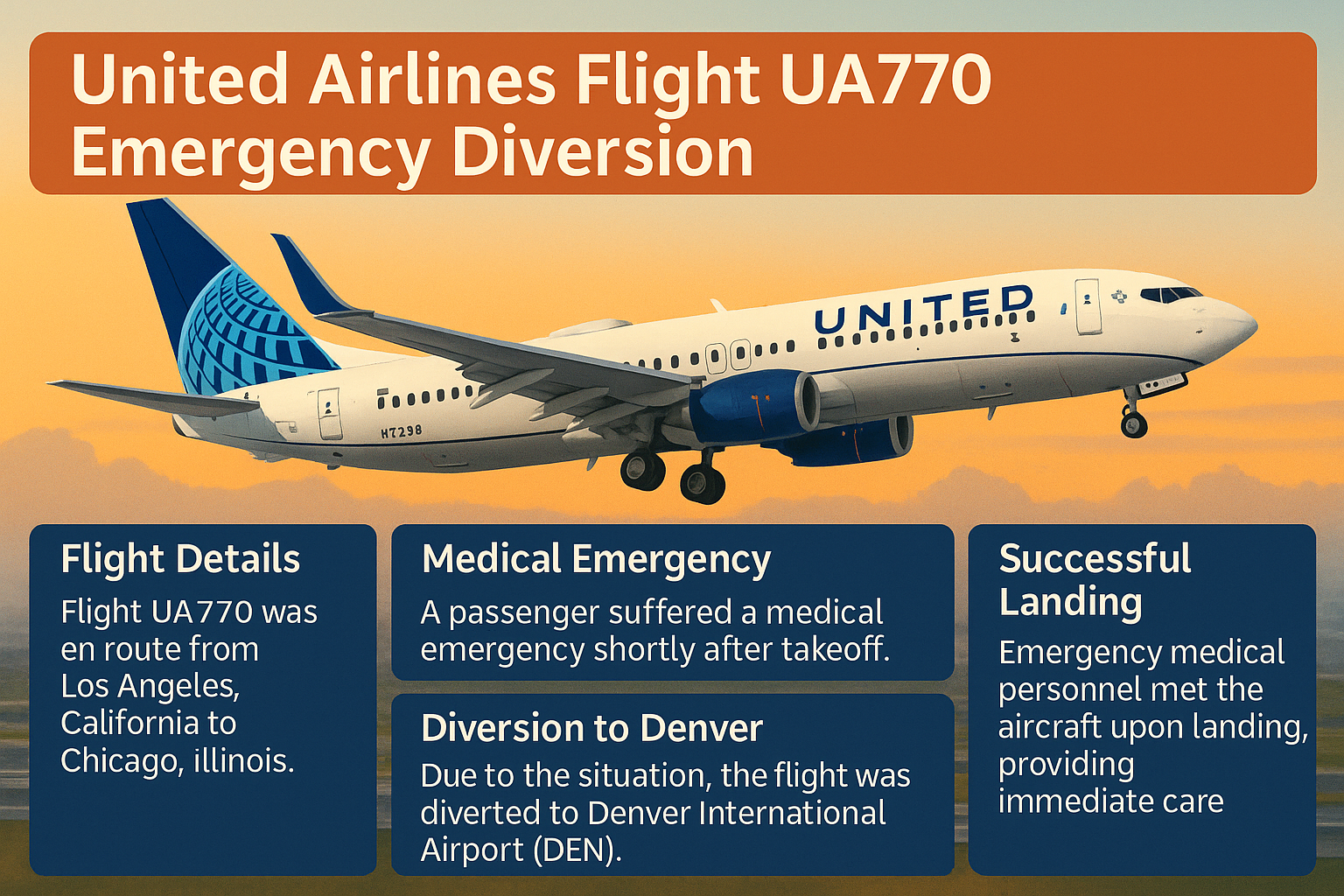On March 15, 2025, united airlines flight ua770 emergency diversion was executed after an engine fire warning was detected. The Boeing 777 traveling from San Francisco (SFO) to Sydney (SYD) diverted to Honolulu (HNL). The crew followed strict emergency procedures, ultimately landing safely with all onboard fine.
Flight path and aircraft specifics
Flight UA770 departed SFO heading toward SYD with 280 passengers and 15 crew members aboard a Boeing 777‑200ER. After about five hours in flight and while over the Pacific Ocean, the pilots received a fire alert in the left engine, prompting immediate action.
Reason for emergency diversion
An indication of fire or overheat in the left engine triggered the alert. Even though no visible flames were reported, the engine control system flagged a serious issue. Because safety rules require immediate diversion, the pilots rerouted to Honolulu, the nearest suitable airport with skilled maintenance and medical support.
Timeline of events on board
-
Departure: UA770 took off on time from SFO
-
Alert: Engine fire warning appeared mid‑cruise
-
Decision: Captains conferred and contacted operations, then notified ATC
-
Diversion: Cleared by Honolulu center for emergency landing
-
Touchdown: Aircraft landed at HNL runway 4R with fire trucks on standby
Landing emergency coordination
Once diverted, ground control prepared emergency response units including fire crews and paramedics. The runway was cleared promptly, and landing was completed without incident. Passengers deplaned normally.
Crew communication and passenger care
Pilots informed passengers calmly and clearly. Cabin crew explained next steps and provided water and snack packs. After arriving in Honolulu, passengers were guided to the terminal and offered options for onward travel or a hotel stay.
Technical analysis: engine fire warning
The Boeing 777’s fire detection system uses infrared and temperature sensors to watch engine conditions. When heat spikes near fire threshold, the system activates alarms. Even without visible damage, the alert alone is enough to cause immediate diversion.
Why Honolulu was chosen
Honolulu International Airport offers long runways, skilled United maintenance teams, and medical support. It is also a busy hub for Pacific routes, making it ideal for handling unexpected emergencies.
How United Airlines responded post-landing
After landing, United provided rebooking, hotel vouchers, meals, and SkyMiles for inconvenience. Meanwhile, engineers inspected the aircraft. Once cleared by safety standards and engine checks, the plane returned to service within 24 hours.
Operational and cost impact
This emergency diversion involved additional fuel, ramp fees, and passenger accommodations. While the airline incurred significant cost, protecting lives and aircraft integrity outweighed any financial losses.
Safety procedures and quick decision-making
Flight crews are trained to react within minutes when alarms trigger. Captains receive simulator training for engine fire scenarios. Systems are tested regularly. Because of these protocols, passengers remain safe—even during unexpected situations.
Passenger advice during emergencies
If onboard a diverted flight, keep your belongings close, listen to crew instructions, and remain calm. Airline apps usually send real-time updates. Having medication or essentials in carry-on helps during sudden reroute situations.
Comparisons with similar incidents
UA770 is one example among several diversions. For instance, Qatar Airways and ANA have diverted wide-body flights due to engine indicators. Data shows emergency diversions are rare but handled with precision at major hub airports.
Aircraft technology and environmental context
The 777‑200ER is a reliable aircraft, but engine sensors are critical for safety. Flying over the Pacific means no quick return—so pilots choose the nearest safe airport, such as HNL, to avoid risk at sea.
Future trends in flight safety
Aviation is embracing AI-based engine diagnostics and predictive maintenance. Enhanced sensors aim to detect performance drops early and reduce diversions. Such tech improvements help reduce disruptions while maintaining safety.
Supporting crew and training insights
Flight crew training emphasizes emergency procedures and passenger reassurance. Crew members practice scenarios regularly so that when an alert sounds, everyone knows what to do and passengers are guided efficiently.
How problems are fixed onboard
If the engine is confirmed safe, the flight may continue after maintenance. In UA770’s case, ground staff, technicians and parts resources at Honolulu enabled repair and inspection, clearing the plane for later service.
Passenger feedback and airline reviews
Many passengers praised United’s swift communication and hospitality. Social media posts highlighted complimentary meals and the calm demeanor of staff. These responses reflect the value of preparation and service.
Rare but serious nature of diversions
Diversions account for under 0.2% of long-haul flights. Common triggers include mechanical faults or medical emergencies. This incident underscores the importance of efficient infrastructure at diversion airports.
Lessons and continuous improvement
United continues enhancing protocols based on UA770. Future changes include better alert systems, improved cabin updates, and refined passenger support during long diversions.
FAQs About united airlines flight ua770 emergency diversion
Why was united airlines flight ua770 emergency diversion necessary?
Because a fire alarm sounded in the engine and safety protocols required immediate diversion.
Was any passenger or crew injured during this event?
No injuries were reported. Everyone landed safely and disembarked without issue.
Could the flight have resumed after landing?
Yes, after inspection and clearance, the aircraft returned to service within a day.
How does the engine fire warning system work?
Temperature and infrared sensors monitor engine heat; thresholds trigger alerts even without visible damage.
How frequent are diversions like this on long-haul flights?
They’re rare—less than 1 in 500. Airlines train for these situations to keep them safe and controlled.
What assistance is offered to passengers after landing?
United offers hotel stays, meals, rebooking, and loyalty points as compensation.
Conclusion
The united airlines flight ua770 emergency diversion shows how airline safety protocols, crew training, and airport readiness work together to protect every traveler—even when emergencies arise far from home. While the event disrupted a long-haul flight, swift action ensured a safe outcome. Airlines and hubs like Honolulu play key roles in keeping passengers safe during rare but critical incidents. Overall, safety and preparedness proved more important than schedules—especially over open skies.
